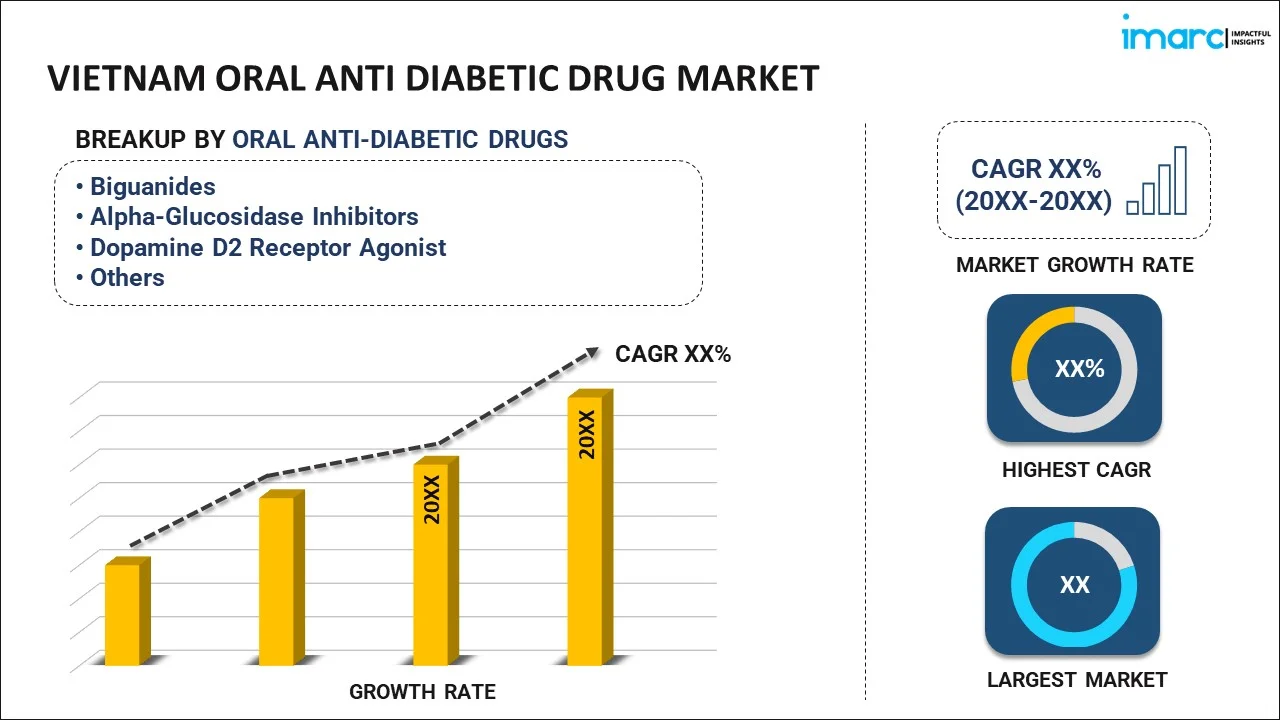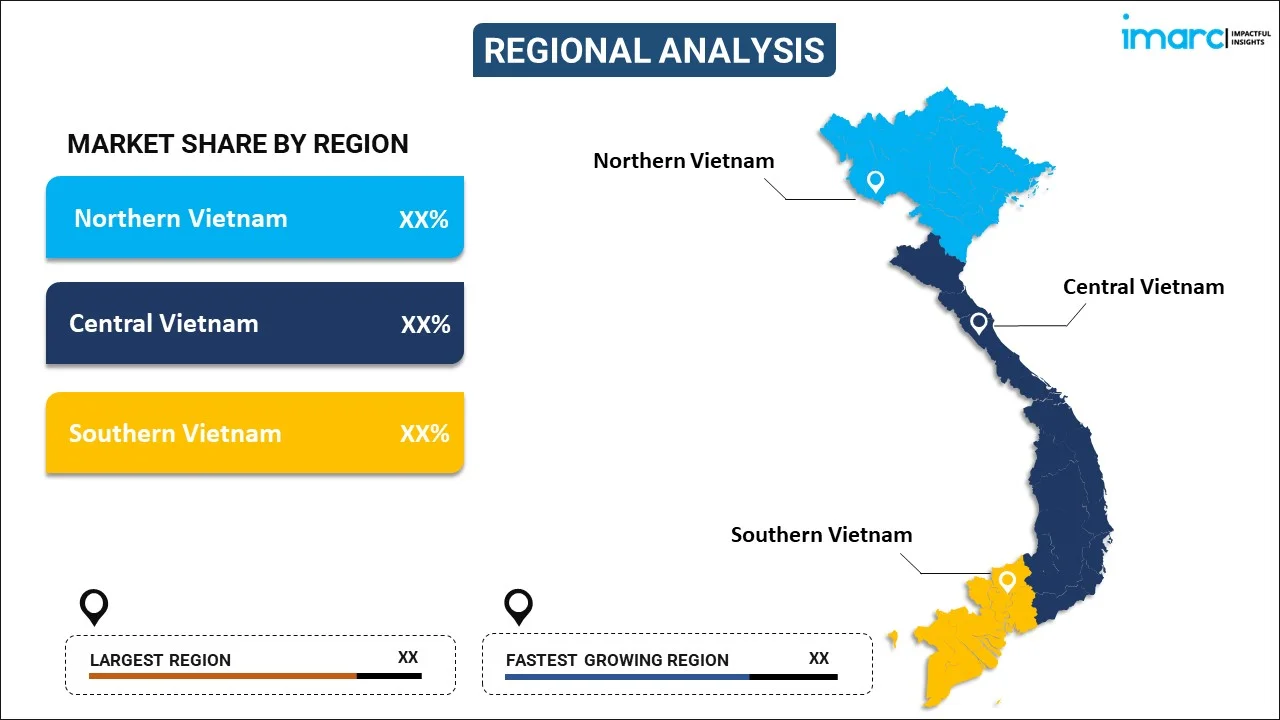
Vietnam Oral Anti Diabetic Drug Market Report by Oral Anti-Diabetic Drugs (Biguanides, Alpha-Glucosidase Inhibitors, Dopamine D2 Receptor Agonist, SGLT-2 Inhibitors, DPP-4 Inhibitors, Sulfonylureas, Meglitinides), and Region 2024-2032
Market Overview:
Vietnam oral anti diabetic drug market size is projected to exhibit a growth rate (CAGR) of 3.56% during 2024-2032. The rising prevalence of diabetes, the introduction of a diverse range of oral anti-diabetic drugs, the rapid expansion of healthcare facilities and the easy availability of skilled healthcare professionals represent some of the key factors driving the market.
|
Report Attribute
|
Key Statistics
|
|---|---|
|
Base Year
|
2023 |
|
Forecast Years
|
2024-2032 |
|
Historical Years
|
2018-2023
|
| Market Growth Rate (2024-2032) | 3.56% |
Oral anti-diabetic drugs are pharmaceutical medications designed to manage and control high blood sugar levels in individuals with diabetes mellitus. These drugs are taken orally, typically in the form of tablets or capsules, and work by various mechanisms to help regulate blood glucose levels. They are an essential component of diabetes management, often used alongside lifestyle modifications and insulin therapy. The primary goal of oral anti-diabetic drugs is to lower blood sugar levels within a healthy range, thus reducing the risk of complications associated with diabetes, such as cardiovascular disease, kidney problems, and nerve damage. These medications work in different ways, including stimulating insulin production, increasing insulin sensitivity in cells, or slowing down the absorption of glucose from the digestive tract. It is crucial for individuals with diabetes to work closely with healthcare professionals to determine the most suitable oral anti-diabetic drug(s) based on their specific needs and medical history. Regular monitoring of blood glucose levels and adherence to prescribed medication regimens are essential to achieve effective diabetes management and maintain overall health.
Vietnam Oral Anti Diabetic Drug Market Trends:
The rising prevalence of diabetes among the masses due to changes in lifestyle, dietary habits, and an aging population is driving the global market. This has created a substantial patient pool in need of oral anti-diabetic medications, thereby impelling the market. Moreover, government initiatives have also played a crucial role in catalyzing this market. The Vietnamese government has taken steps to improve healthcare access and affordability, including providing support for diabetes management programs. This has made oral anti-diabetic drugs more accessible to a broader segment of the population. Furthermore, pharmaceutical companies operating in Vietnam have been actively introducing and promoting innovative oral anti-diabetic drugs. These companies are investing heavily in research and development (R&D) activities to bring new, more effective medications to the market, which is acting as a significant growth-inducing factor. Apart from this, the easy availability of a diverse range of oral anti-diabetic drugs with varying mechanisms of action has provided healthcare professionals with more treatment options, which in turn is increasing the overall market demand. Besides this, the heightened awareness about diabetes and its management has played a pivotal role. Health campaigns and educational efforts have helped inform the public about the importance of early diagnosis and treatment of diabetes, thereby leading to a higher demand for oral anti-diabetic drugs as part of diabetes management. Additionally, healthcare infrastructure improvements have made it easier for patients to access healthcare services, including diabetes diagnosis and treatment, which is fueling the market. The expansion of healthcare facilities and the rising number of skilled healthcare professionals are also contributing to the growth of the oral anti-diabetic drug market.
Vietnam Oral Anti Diabetic Drug Market Segmentation:
IMARC Group provides an analysis of the key trends in each segment of the market, along with forecasts at the country level for 2024-2032. Our report has categorized the market based on oral anti-diabetic drugs.
Oral Anti-Diabetic Drugs Insights:

- Biguanides
- Alpha-Glucosidase Inhibitors
- Dopamine D2 Receptor Agonist
- SGLT-2 Inhibitors
- Invokana (Canagliflozin)
- Jardiance (Empagliflozin)
- Farxiga/Forxiga (Dapagliflozin)
- Suglat (Ipragliflozin)
- DPP-4 Inhibitors
- Onglyza (Saxagliptin)
- Tradjenta (Linagliptin)
- Vipidia/Nesina (Alogliptin)
- Galvus (Vildagliptin)
- Sulfonylureas
- Meglitinides
The report has provided a detailed breakup and analysis of the market based on the oral anti-diabetic drugs. This includes biguanides, alpha-glucosidase inhibitors, dopamine d2 receptor agonist, sglt-2 inhibitors {(invokana (canagliflozin), jardiance (empagliflozin), farxiga/forxiga (dapagliflozin), suglat (ipragliflozin)}, dpp-4 inhibitors {(onglyza (saxagliptin), tradjenta (linagliptin), vipidia/nesina (alogliptin), galvus (vildagliptin)}, sulfonylureas, and meglitinides.
Regional Insights:

- Northern Vietnam
- Central Vietnam
- Southern Vietnam
The report has also provided a comprehensive analysis of all the major regional markets, which include Northern Vietnam, Central Vietnam, and Southern Vietnam.
Competitive Landscape:
The market research report has also provided a comprehensive analysis of the competitive landscape in the market. Competitive analysis such as market structure, key player positioning, top winning strategies, competitive dashboard, and company evaluation quadrant has been covered in the report. Also, detailed profiles of all major companies have been provided.
Vietnam Oral Anti Diabetic Drug Market Report Coverage:
| Report Features | Details |
|---|---|
| Base Year of the Analysis | 2023 |
| Historical Period | 2018-2023 |
| Forecast Period | 2024-2032 |
| Units | US$ Million |
| Scope of the Report | Exploration of Historical Trends and Market Outlook, Industry Catalysts and Challenges, Segment-Wise Historical and Future Market Assessment:
|
| Oral Anti-Diabetic Drugs Covered |
|
| Regions Covered | Northern Vietnam, Central Vietnam, Southern Vietnam |
| Customization Scope | 10% Free Customization |
| Report Price and Purchase Option | Single User License: US$ 3699 Five User License: US$ 4699 Corporate License: US$ 5699 |
| Post-Sale Analyst Support | 10-12 Weeks |
| Delivery Format | PDF and Excel through Email (We can also provide the editable version of the report in PPT/Word format on special request) |
Key Questions Answered in This Report:
- How has the Vietnam oral anti diabetic drug market performed so far and how will it perform in the coming years?
- What has been the impact of COVID-19 on the Vietnam oral anti diabetic drug market?
- What is the breakup of the Vietnam oral anti diabetic drug market on the basis of oral anti-diabetic drugs?
- What are the various stages in the value chain of the Vietnam oral anti diabetic drug market?
- What are the key driving factors and challenges in the Vietnam oral anti diabetic drug?
- What is the structure of the Vietnam oral anti diabetic drug market and who are the key players?
- What is the degree of competition in the Vietnam oral anti diabetic drug market?
Key Benefits for Stakeholders:
- IMARC’s industry report offers a comprehensive quantitative analysis of various market segments, historical and current market trends, market forecasts, and dynamics of the Vietnam oral anti diabetic drug market from 2018-2032.
- The research report provides the latest information on the market drivers, challenges, and opportunities in the Vietnam oral anti diabetic drug market.
- Porter's five forces analysis assist stakeholders in assessing the impact of new entrants, competitive rivalry, supplier power, buyer power, and the threat of substitution. It helps stakeholders to analyze the level of competition within the Vietnam oral anti diabetic drug industry and its attractiveness.
- Competitive landscape allows stakeholders to understand their competitive environment and provides an insight into the current positions of key players in the market.
Need more help?
- Speak to our experienced analysts for insights on the current market scenarios.
- Include additional segments and countries to customize the report as per your requirement.
- Gain an unparalleled competitive advantage in your domain by understanding how to utilize the report and positively impacting your operations and revenue.
- For further assistance, please connect with our analysts.
 Inquire Before Buying
Inquire Before Buying
 Speak to an Analyst
Speak to an Analyst
 Request Brochure
Request Brochure
 Request Customization
Request Customization




.webp)




.webp)












